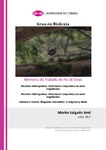Revisión bibliográfica: orientación magnética en aves migratorias

Use this link to cite
http://hdl.handle.net/2183/24334Collections
- Traballos académicos (FCIE) [1007]
Metadata
Show full item recordTitle
Revisión bibliográfica: orientación magnética en aves migratoriasAlternative Title(s)
Literature review: magnetic orientation of migratory birdsAuthor(s)
Directors
Domínguez-Pérez, MontserratCabeza Gras, Óscar
Date
2019Center/Dept./Entity
Universidade da Coruña. Facultade de CienciasDescription
Traballo fin de grao (UDC.CIE). Bioloxía. Curso 2018/2019Abstract
[Resumen]: Este trabajo pretende agrupar información sobre el sistema de orientación mediante compás magnético en aves migratorias.
A pesar de que este sistema de orientación no es el único del que disponen las aves, sí es una fuente omnipresente de información orientativa no dependiente de factores externos como las condiciones climáticas.
Las aves se orientan por este sistema magnético en un proceso de dos pasos: 1- El mapa, que mediante variaciones en parámetros como la intensidad del campo magnético terrestre aporta información sobre la posición geográfica.
2- El compás, que mediante la inclinación del vector de la línea de fuerza del campo magnético respecto a la gravedad aporta información direccional, ya que este compás es de inclinación y no de polaridad, la dirección aportada es dirección polo o dirección ecuador.
Además de entender cómo funciona el sistema de navegación magnético en aves, trataré de esclarecer los modelos de magnetorrecepción propuestos, en los cuales se discuten dos hipótesis, una basada en un mecanismo de pares de radicales y otro que involucra partículas de magnetita. [Abstract]: This work aims to summarize information to approach the magnetic compass orientation mechanism of migratory birds. Although this guidance system is not the only one available to birds, it is an omnipresent source of orientation information not dependent on external factors such as weather conditions.
The birds get orientation with this magnetic system in a two-step process:
1-The map: variations in parameters such as the intensity of the earth's magnetic field provide information on the geographical position.
2- The compass: the inclination of the magnetic field force vector with respect to gravity provides directional information, towards pole or equator direction.
In addition to understand how the magnetic navigation system works in birds, I will try to clarify the proposed models of magnetorerception, in which two hypotheses are discussed, one based on a mechanism of radical pairs and another one involving magnetite particles.
Keywords
Aves
Orientación magnética
Magnetorrecepción
Birds
Magnetic orientation
Magnetoreception
Orientación magnética
Magnetorrecepción
Birds
Magnetic orientation
Magnetoreception





